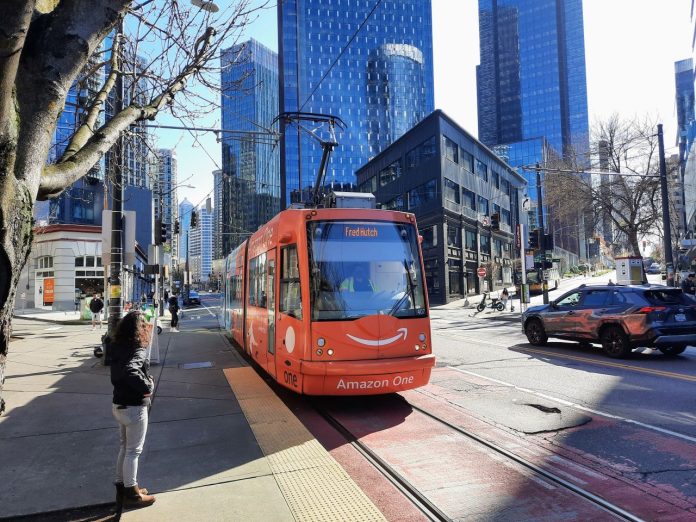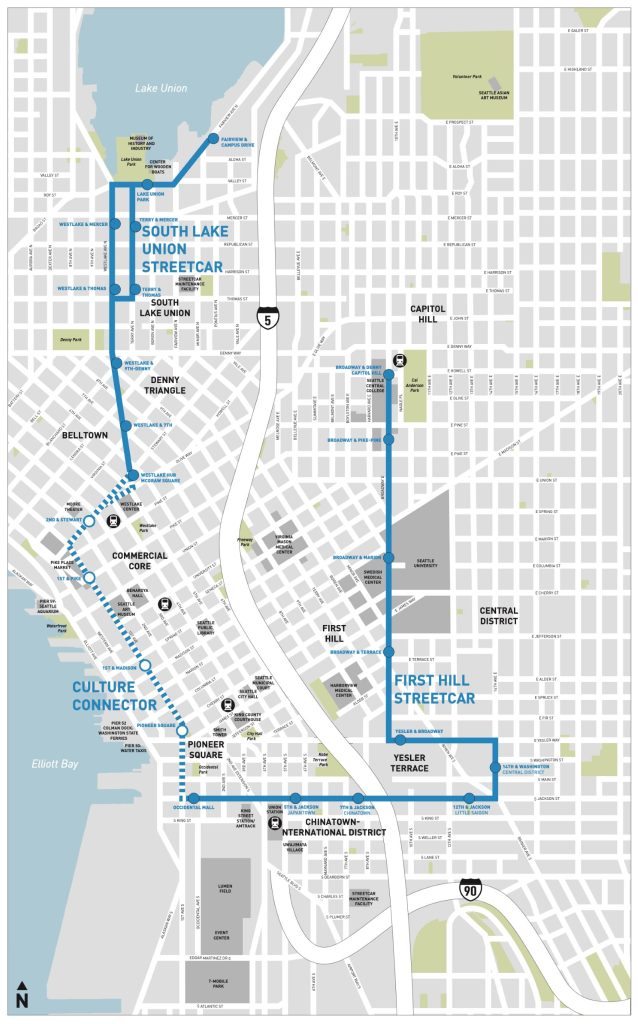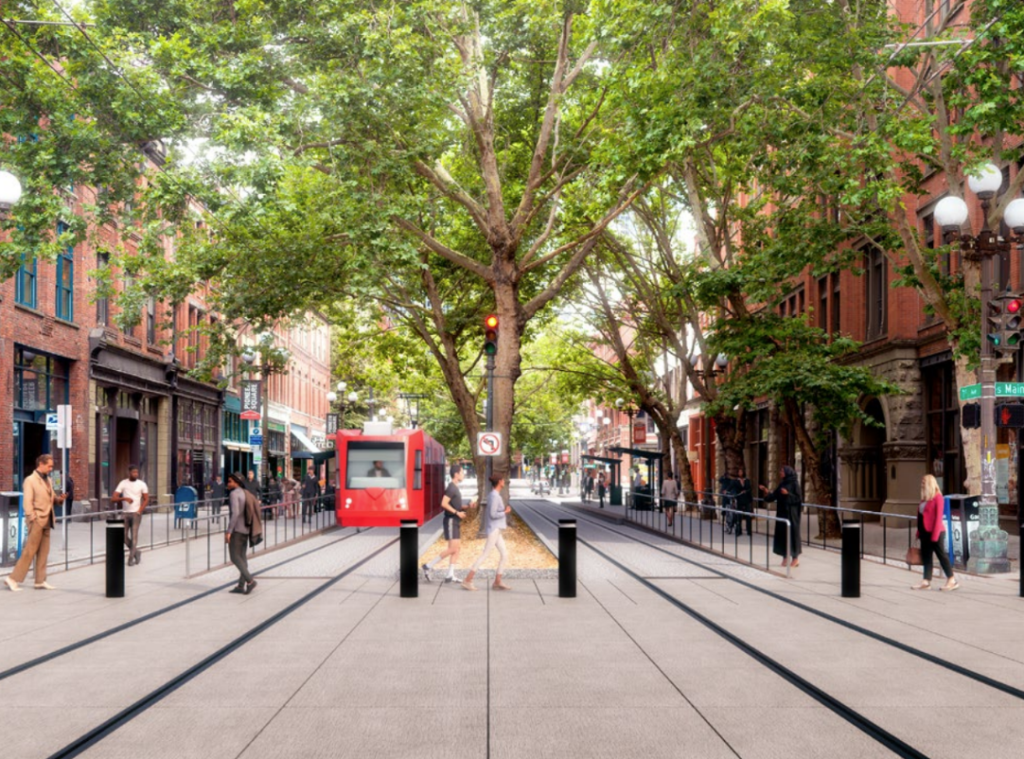
Since Friday, Seattle has suspended service on the 1.3-mile-long South Lake Union streetcar due to an electrical outage that will take “several weeks” to address. Both of the line’s electric substations have failed due to worn out specialized parts that King County Metro reported will need to procure from overseas due to a lack of a North American supplier.
“King County Metro’s electrical vendor that supports streetcar operations identified worn-out control units that manage the high-voltage breakers at one substation in July,” Metro spokesperson Jeff Switzer said in a news release. “In response, the maintenance team began working to obtain highly specialized replacement parts which are not readily available in North America. Service was temporarily scaled back to reduce the power load on the remaining substation.”
Unfortunately, the remaining substation wasn’t able to hold out, even with the reduced schedule. The streetcar is owned by the Seattle Department of Transportation (SDOT) and operated by King County Metro, but the agencies use an outside vendor to handle the electrical work on the line. None of the three have been able to ascertain the cause of the parts failure as of yet.
“We are working with our vendor to determine why the parts failed,” Switzer said. “Streetcar service will be suspended until further notice while repairs are being made. The exact repair timeline is still being determined, and it is currently expected to take several weeks to obtain and install parts for four control units and up to four high-voltage breakers. Metro and SDOT are working together to expedite the work to the extent possible to restore service as soon as possible.”

Metro has encouraged transit riders to use alternate bus service while the streetcar is offline. The RapidRide C Line, Route 40, and Route 70 also serve the Westlake Avenue corridor, usually at greater frequencies. The SLU streetcar runs from Westlake Square (adjacent to light rail and monorail service at Westlake Station) to Fred Hutchinson Cancer Center, cutting through Amazon’s corporate campus on the way.
- Route 40: Timetable and route map.
- Route 70: Timetable and route map.
- RapidRide C Line: Timetable and route map.
Ridership on the South Lake Union Streetcar is relatively anemic, as it carries just shy of 500 weekday rides, as of the latest June figures. The First Hill Streetcar carries about 3,600 average weekday passengers, making it a much more integral part of the transit network. It remains in operation as normal.
The SLU streetcar’s weak ridership is hardly a shock given its short length and more frequent bus service in the corridor. However, since its launch in 2007, the intent and promise had always been to extend the SLU line through Downtown along First Avenue, connecting the route with the First Hill Streetcar, which would also take advantage of the downtown extension.
However, Mayor Jenny Durkan pulled the plug on the funded and shovel-ready Center City project in 2018, citing concerns about alleged design errors and cost overruns. Since then, the project has been in limbo, with no subsequent council or mayor fulling abandoning the project, but not resurrecting it either via restored funding.
Mayor Bruce Harrell had voiced some measured support for the streetcar as a tool of downtown recovery and cultural connection, since the First Hill line runs through the Chinatown-International District. However, he ultimately opted against funding the project via his eight-year transportation levy proposal, which ended up at $1.55 billion after a few additions. Facing a quarter-billion-dollar budget deficit, Harrell said the streetcar project’s budget had ballooned too high in the intervening years — as it sat on a shelf facing the ravages of inflation. Bundled with utility upgrades, the latest estimate put the Center City streetcar’s cost at $410 million.

South Lake Union Streetcar service faces another hurdle on the horizon with an expected eight-year closure once Sound Transit begins construction on its second downtown light rail tunnel as part of the Ballard Link extension, which the agency hopes to open in 2039. The line will run down Westlake Avenue and put a station near the intersection with Denny Way. With Sound Transit still in a prolonged phase of draft environmental study, that project is still several years away from breaking ground.
Nonetheless, doubts are starting to mount as to whether the South Lake Union Streetcar will be operating by the time light rail work would necessitate a closure.
SDOT estimates the operating cost for the SLU line at $4.6 million this year, and a scheduled phaseout of Sound Transit funding for First Hill Streetcar operations will put strain on the Seattle Streetcar budget. It remains to be seen whether the Seattle City Council will continue to fund the less productive streetcar through a City budget crisis, with most councilmembers pledging to pursue major budget cuts rather than new revenue.
In fact, even before this unexpected weekslong electric outage that highlighted maintenance costs coming due for an aging line, The Urbanist had suggested that the SLU streetcar’s future was dim and its days numbered without the City committing to finally build the Center City extension. This temporary closure could either be impetus to pursue extension with renewed vigor or bow to the streetcar skeptics who have wanted to pull out the tracks since they were laid.
Doug Trumm is publisher of The Urbanist. An Urbanist writer since 2015, he dreams of pedestrian streets, bus lanes, and a mass-timber building spree to end our housing crisis. He graduated from the Evans School of Public Policy and Governance at the University of Washington in 2019. He lives in Seattle's Fremont neighborhood and loves to explore the city by foot and by bike.

